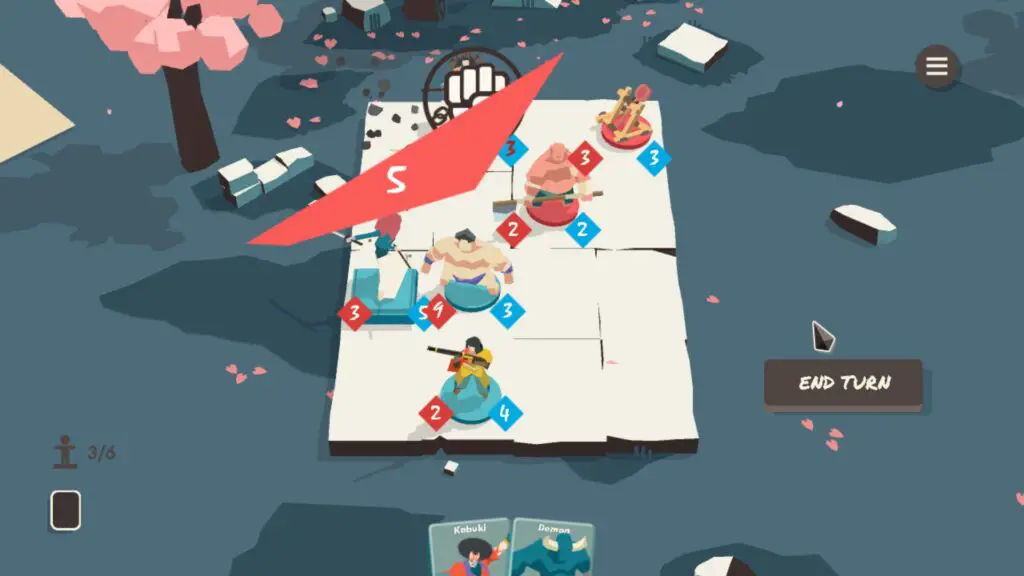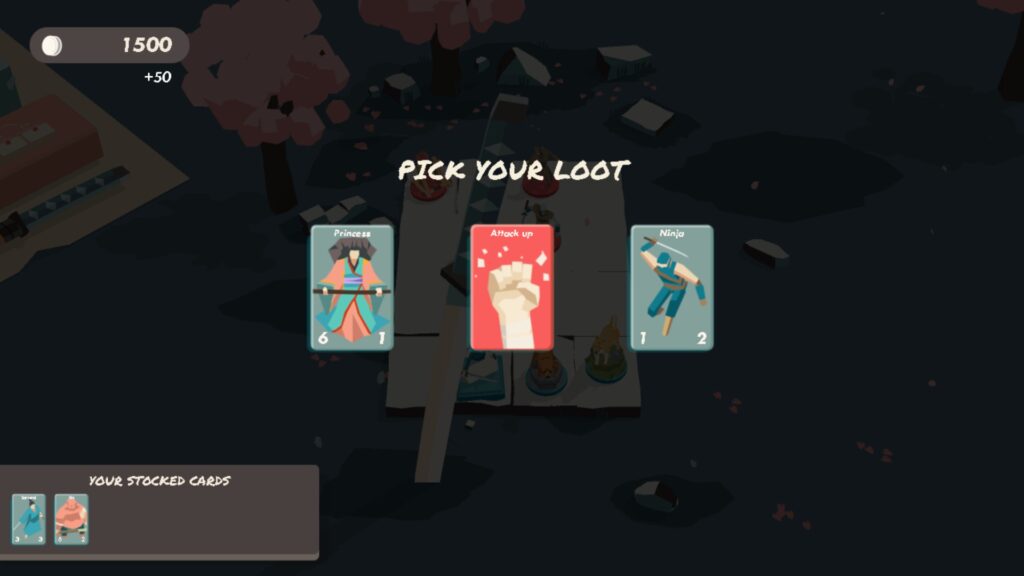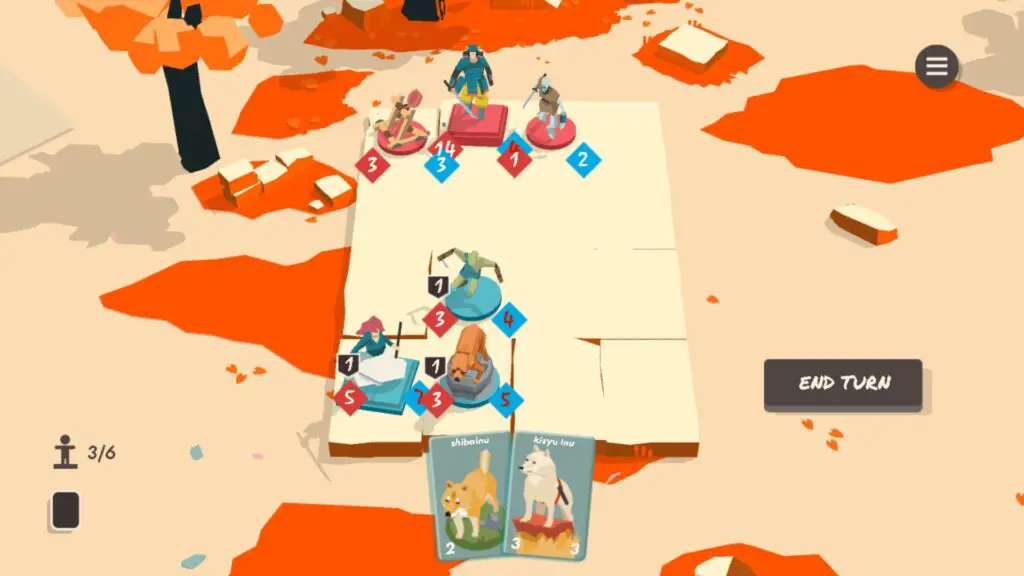Miyamoto Musashi (1584-1645) was a renowned Japanese swordsman from the early Edo period. In the West, he is most famous as the author of the Book of Five Rings. However, he was also a talented artist and a devout Buddhist; While his two-sword fighting style earned him widespread recognition, despite his status as a ronin (a wandering warrior, without a lord): He remained undefeated in the 61 duels he fought over the course of his life.

In Miyamoto S – the recent indie title from developer hidekihanida, the player takes on the role of one of Miyamoto’s many challengers. Through fast-paced card-based tactical skirmishes, you’ll hone your skills and gather followers – preparing to cross blades with the man who, quite literally, wrote the book on samurai swordsmanship.
Gameplay

Miyamoto S is a quick roguelike, with the look and feel of a boxed board game. Each run consists of a series of progressively difficult battles, which culminate in a showdown with Miyamoto himself. The opponents you’ll face during each stage are semi-random; the pool of available foes changes the closer you get to Miyamoto. The farther along you are, the more dangerous the enemies you’ll encounter.
In combat, both your character and your opponent will square off on a 4×4 grid. The encounter begins with only the two rivals on the board. However, it will quickly become filled with warriors, as each fighter calls on their allies to help. The objective is simple – defeat the opposing hero, denoted by a square base rather than the round base of the followers.
Each character has an attack rating and hit points. Most card games display attack on the left and health on the right: Hearthstone, Magic: The Gathering, etc. Miyamoto S does the opposite. If you’re used to the more common format, this could be confusing and lead to misplays in your first couple of games.
Most characters have a fairly low HP pool, so turnover is very rapid. Finding ways to gain a numerical advantage without putting your own pieces at risk is essential. This is especially true in the later battles. As with any good game, each character has unique abilities. These allow them to affect the battlefield beyond simply fighting and dying. A karateka, for example, can train adjacent units, permanently increasing their attack.

In addition to followers, there are also spell cards, to use on the battlefield. While comparatively rare, these provide a range of useful effects. Some can deal direct damage to the enemies. Others allow a unit to activate the same turn it comes into play. There’s even an achievement for winning a fight using only spells. Easier said than done – without a perfect hand.
A hand of cards determines what spells and followers are available. Each turn, you’ll draw four cards from the deck. These are then played freely. There is also a thief follower, weak but useful – who can allow you to draw two more. At the beginning of each battle, both the player and the AI opponent get some cards to draft. There’ll be four sets of two of these before you; for each, you select one to add to your deck and your opponent gets the other. After you’ve selected your hand, it is revealed which ones the opponent gave to you. These eight cards form the basis of your deck for that match.

In addition, you also have a fixed deck of standard cards. These are present at all times. At the end of each successful battle, you get to claim one card as Loot. It goes to your deck for the remainder of the run. By the time you reach Miyamoto, you should have a deck capable of, at least, putting up a decent fight.
If your character dies, the run ends, and you’ll have to start over from the very beginning. At first, the only character available is the Ronin. She’s not bad, as far as starting characters go, with enough attack power to easily dispatch most followers. Her lack of special ability and low hit points make her something of a glass cannon, however. You’ll definitely want to unlock additional heroes as soon as possible.

Each victory earns you gold, which persists between runs. Its use is to unlock new playable heroes: from the legendary ninja Hanzo to Miyamoto himself. You can even unlock and play as a bear – and why not? Admittedly, some of these characters might be a bit too good. Hanzo in particular has a devastating area attack that makes early battles a simple affair. He’s also an incredibly dangerous opponent if you’re unlucky enough to encounter him near the end of a run: Because followers have to be deployed adjacent to a friendly character, he can clear your board before you have a chance to react.
Graphics & Sound

Miyamoto S is a stylish, well-presented game. The creator’s love of the tabletop style is apparent – and the opening of the box at the beginning of each run makes for a ritualistic-like feel, that works well with the game’s meditative vibe. The characters are all bright, colorful, and easily distinguished from one another.
The UI, however, could use a few visual improvements. For one thing, when the board becomes crowded, the units’ stats can overlap, making these completely illegible. This obviously is a big problem, when trying to make informed gameplay decisions. Targeting with spells is also cumbersome – you need to position your cursor exactly over your target, while the card you’re dragging into play obscures most of the board. This doesn’t happen when deploying followers, but misclicking a Fireball is predictably disastrous.
The soundtrack for Miyamoto S is an evocative blend of traditional Japanese music. It fits perfectly with the game’s theme, and together with the character and background design lets the player feel like they’re in a Kurosawa movie. As far as creating immersion through minimalism goes, it doesn’t get much better than this.
Dogs

Several units are dogs. One even carries a sword in its mouth. These very good boys provide significant buffs to nearby allies when deployed. They are also decent fighters in their own right. Drafting dogs whenever possible is – rightly – a strong strategy.
Overall
Although far from perfect, Miyamoto S is a solid and fast-paced game. A single run takes only about thirty minutes, while unlocking new heroes makes it worthwhile to come back and try again. The gameplay isn’t anything new or innovative, but it’s well-crafted and is challenging enough that a victory against Miyamoto truly feels rewarding. There are a few issues to iron out – in addition to display problems mentioned above: Sometimes, the game freezes at the start of a match.
That said, it’s a fun little game, and it’s less than $10 USD. The samurai theme is resonant throughout, and the flourishes, like the swirling cherry blossoms, keep the player well-grounded in the setting. The game could also be perfect for head-to-head play – it’s a shame that there’s no multiplayer option. Overall, if you’re into the 17th-century Japanese aesthetic and are looking for a new game to try on the cheap, this is absolutely a worthwhile choice.







